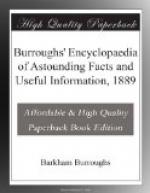BLUNDERS AND ABSURDITIES IN ART.
In looking over some collections of old pictures, it is surprising what extraordinary [Transcriber’s Note: The original text reads ‘anachornisms’] anachronisms, blunders, and absurdities are often discoverable.
In the gallery of the convent of Jesuits at Lisbon, there is a picture representing Adam in paradise, dressed in blue breeches with silver buckles, and Eve with a striped petticoat. In the distance appears a procession of Capuchin monks bearing the cross.
In a country church in Holland there is a painting representing the sacrifice of Isaac, in which the painter has depicted Abraham with a blunderbus in his hand, ready to shoot his son. A similar edifice in Spain has a picture of the same incident, in which the patriarch is armed with a pistol.
At Windsor there is a painting by Antonio Verrio, in which the artist has introduced the portraits of himself, Sir Godfrey Kneller, and May, the surveyor of the works of that period, all in long periwigs, as spectators of Christ healing the sick.
A painter of Toledo, having to represent the three wise men of the East coming to worship on the nativity of Christ, depicted three Arabian or Indian kings, two of them white and one black, and all of them in the posture of kneeling. The position of the legs of each figure not being very distinct, he inadvertently painted three black feet for the negro king, and three also between the two white kings; and he did not discover his error until the picture was hung up in the cathedral.
In another picture of the Adoration of the Magi, which was in the Houghton Hall collection, the painter, Brughel, had introduced a multitude of little figures, finished off with true Dutch exactitude, but one was accoutred in boots and spurs, and another was handing in, as a present, a little model of a Dutch ship.
The same collection contained a painting of the stoning of Stephen, the martyr, by Le Soeur, in which the saint was attired in the habit of a Roman Catholic priest at high mass.




